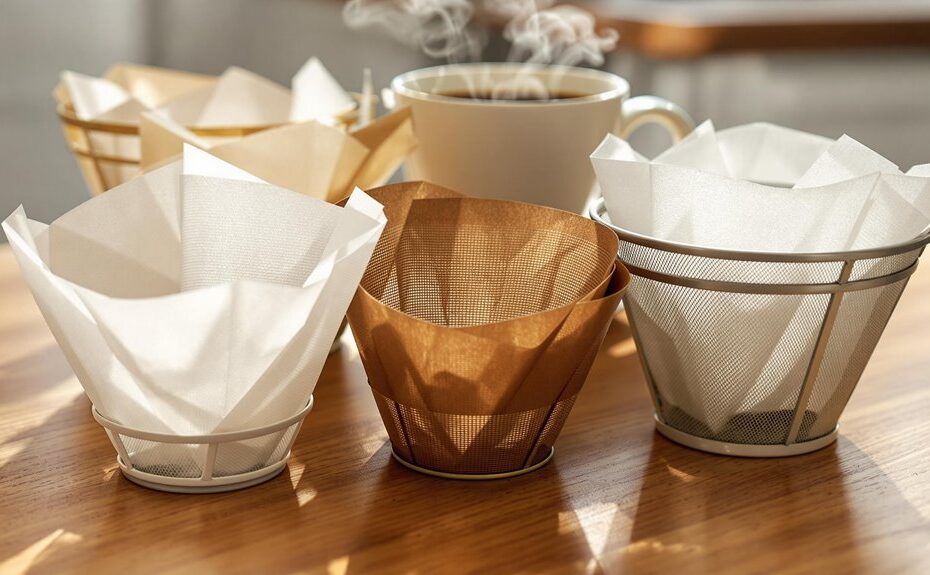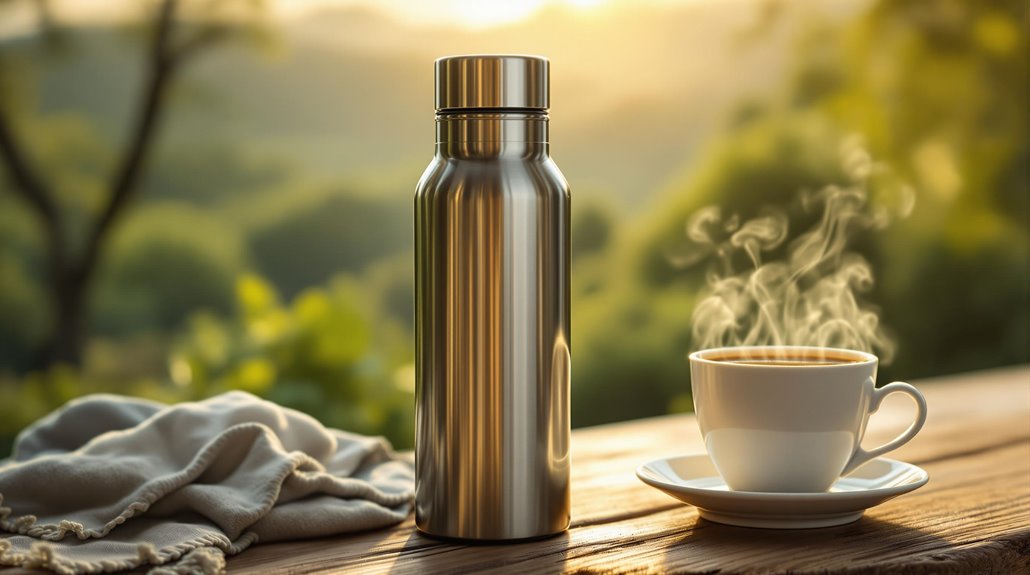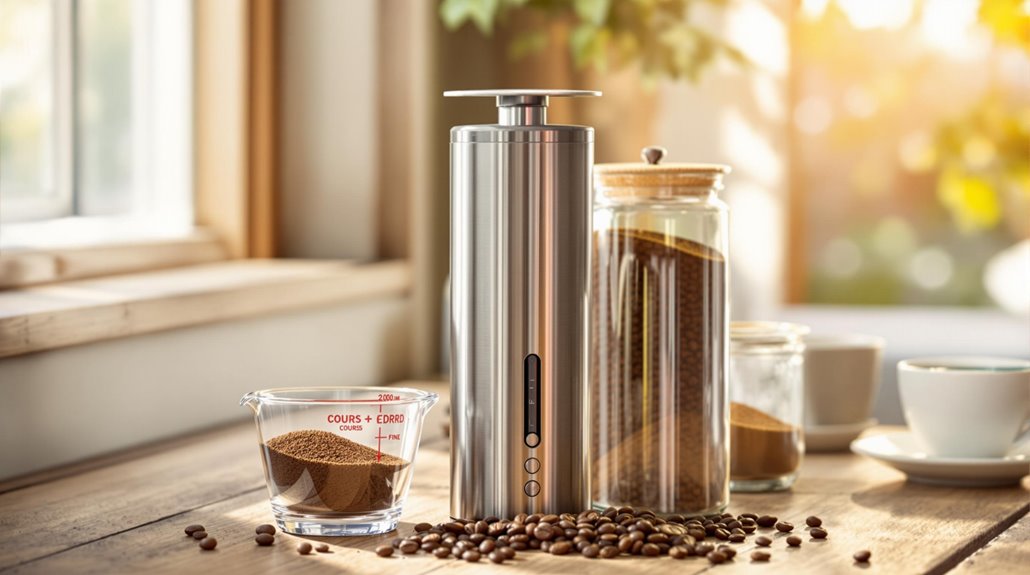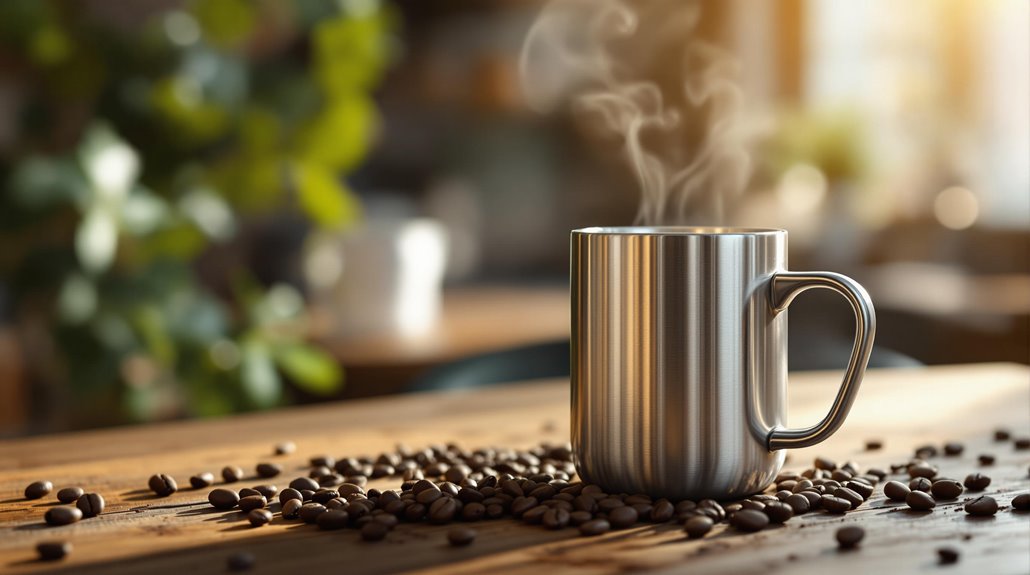







Many people believe that the type of coffee filter you use can drastically change the taste of your brew. While there's some truth to that, the choices can be overwhelming, especially with various materials, shapes, and brewing methods involved. So, how do you determine which filter will best suit your preferences and equipment? Understanding the nuances of each option can lead to a more satisfying cup, but it requires a closer look at factors like flavor, sustainability, and maintenance.
Key Takeaways
- Consider the brewing method: use cone-shaped filters for pour-overs and flat-bottom filters for drip machines to suit your coffee-making style.
- Select paper filters for a cleaner taste or metal/cloth filters for a fuller-bodied flavor with oils and fine particles included.
- Choose unbleached paper filters for an eco-friendly option that avoids chemical processing and is compostable.
- Match filter size to brewing quantity: #2 filters for 1-2 cups, #4 for 8-10 cups, and #6 for 10+ cups to ensure efficient brewing.
- Regularly maintain and clean reusable filters to extend their lifespan and enhance coffee flavor, ensuring optimal performance.
Coffee Filter Materials
When selecting a coffee filter, understanding the various materials available is essential for tailoring your brewing experience. The most common choice is paper filters, which are made from tightly woven, absorbent materials. They effectively trap oils and sediment, resulting in a lighter, cleaner taste that many coffee lovers appreciate. You can find bleached paper filters, which are treated for uniform texture, or unbleached versions that are more eco-friendly but might impart a slight paper taste.
If you're looking for a richer mouthfeel, metal filters are another option. Typically made from stainless steel or gold-tone mesh, these filters allow oils and fine grounds to pass through, giving you a fuller-bodied cup. However, they require regular cleaning to maintain their performance.
Cloth filters, often crafted from cotton or hemp, strike a balance between the two. They catch small particles while allowing oils to flow through, resulting in a full-bodied cup without sediment. While reusable filters like metal and cloth are more sustainable, they necessitate thorough maintenance. By understanding these materials, you can select the filter that best suits your taste preferences and brewing style.
Coffee Filter Shapes

When choosing a coffee filter shape, you'll notice significant differences between cone and flat-bottom designs. Cone-shaped filters typically allow for a slower flow rate, enhancing extraction and creating a richer flavor profile, while flat-bottom filters provide an even extraction that balances sweetness. Additionally, consider your brewing quantity; the shape of the filter can directly affect not just extraction efficiency but also how well your coffee brews based on the amount you're making.
Cone vs. Flat-Bottom
The shape of your coffee filter can substantially influence the flavor profile of your brew, particularly when comparing cone-shaped and flat-bottom filters. Cone filters, like those in the Hario V60, create a deeper coffee bed, resulting in a more concentrated and full-bodied cup. This filter shape tends to emphasize citrus and berry notes, especially in light roasts. However, the slower flow rate can intensify bitterness in dark roasts if not managed carefully.
On the other hand, flat-bottom filters, such as those in the Kalita Wave, provide a larger surface area that promotes even extraction. This results in sweeter, floral, and dried fruit flavors for light roasts while enhancing chocolate notes in dark roasts. They facilitate a consistent water flow, making them easier to use when brewing larger quantities of coffee.
Research from UC-Davis confirms that filter shape has a statistically significant impact on flavor, with cone filters highlighting acidity and flat-bottom filters enhancing sweetness. Ultimately, your choice between cone and flat-bottom filters should depend on the flavor profile you desire and the brewing method you prefer.
Extraction and Flavor Profiles
How does the shape of your coffee filter affect the extraction and flavor profiles of your brew? The choice between cone and flat-bottom filters plays a pivotal role in determining the coffee flavor you'll experience. Cone-shaped filters, like those used in V60 brewers, create a slower, controlled flow rate. This results in a more concentrated cup, enhancing citrus and berry notes, especially in light roasts. However, this method can intensify bitterness in dark roasts due to the deeper coffee bed.
On the other hand, flat-bottom filters, such as those found in Kalita Wave brewers, provide a larger surface area for water contact. This design promotes even extraction, yielding sweeter, floral, and dried fruit flavors in light roasts while enhancing chocolate and woody notes in dark roasts. Research from UC-Davis confirms that filter shape substantially impacts flavor extraction, often more than grind size.
Ultimately, your brewing method and filter types should align with your desired flavor profile. If you favor light roasts, cone filters may be your go-to. For dark roasts, flat-bottom filters can help you achieve a sweeter, less bitter cup.
Brewing Quantity Considerations
Considering brewing quantity is essential when selecting a coffee filter shape, as it directly influences your brew's efficiency and flavor. If you typically brew smaller amounts, cone-shaped filters like #2 are perfect for 1-2 cup pour-overs, while #4 filters suit 8-10 cup coffeemakers. These conical designs promote slower, controlled water flow, allowing for ideal extraction in smaller batches.
On the other hand, if you're brewing larger quantities, flat-bottom filters are your best bet. They provide a larger surface area, ensuring faster and more even extraction for 6-12 cup brews. For even bigger volumes, consider #6 conical filters, designed specifically for 10+ cup coffeemakers, allowing for efficient brewing without sacrificing flavor.
Basket-shaped filters are common in drip machines and can handle medium to large volumes. However, be cautious; overfilling them may lead to uneven extraction. Ultimately, the shape and size of your coffee filters will substantially affect your coffee's taste and consistency, so align your filter choice with your brewing quantity to achieve the best results.
Environmental Considerations
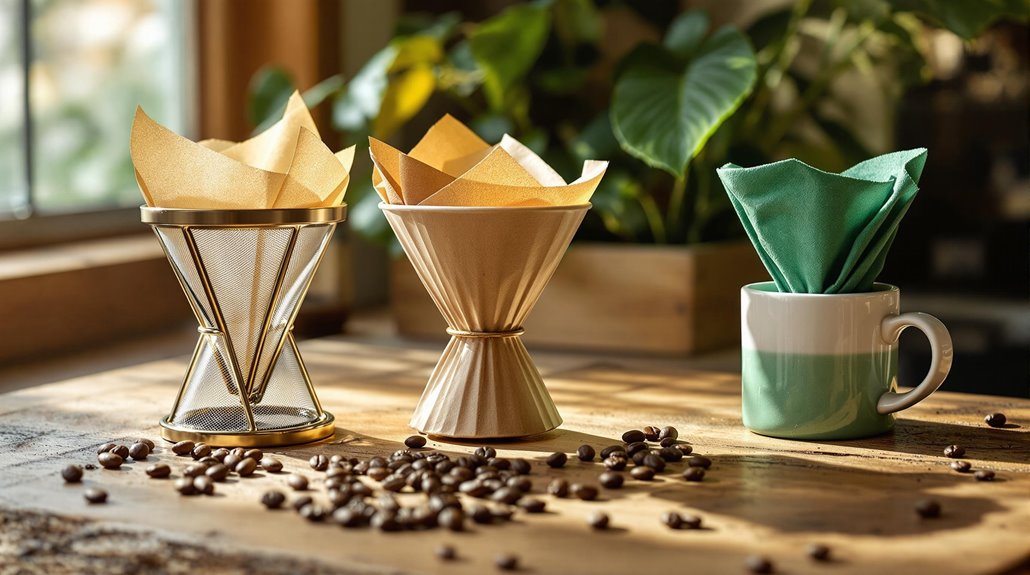
When it comes to selecting a coffee filter, environmental considerations play a pivotal role in your decision-making process. If you're looking to minimize waste, reusable coffee filters like metal or cloth options are excellent choices. These filters substantially reduce the amount of single-use products you toss out, making them more environmentally friendly.
When it comes to paper filters, opting for unbleached paper can lessen your environmental impact. Unlike bleached filters, unbleached options avoid chemical processing, which is better for the planet. While disposable, these paper filters can also be composted, further mitigating waste.
Cloth filters are another viable option, though they require regular washing. While this may increase your water usage slightly, it still eliminates the need for single-use products, creating a more sustainable coffee-brewing routine. Metal coffee filters, often made from durable stainless steel, can last for years, reducing the frequency of replacements and contributing to less waste overall.
Ultimately, weighing these environmental factors will guide you toward a more sustainable coffee experience, ensuring that your love for coffee aligns with your commitment to the planet.
Maintenance and Care
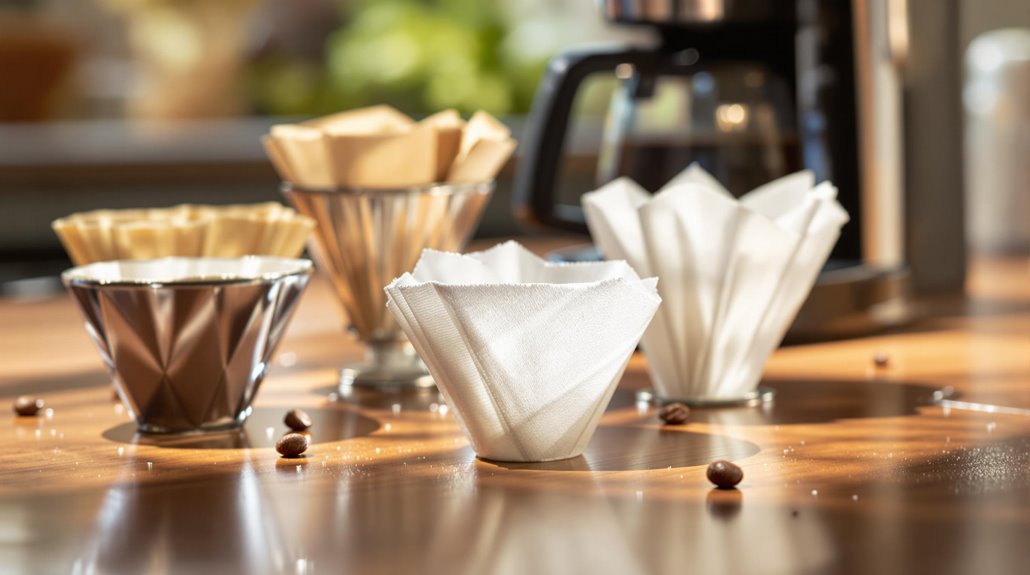
Maintaining your coffee filter is essential for both flavor and hygiene. Depending on the type you choose, you'll need to adopt different cleaning methods and frequencies; for instance, metal filters require deep cleaning with specialized products, while cloth filters demand immediate washing to prevent mold. Additionally, proper drying and storage techniques will help prolong the life of your filter, ensuring that your coffee remains fresh and enjoyable.
Cleaning Methods and Frequency
Properly maintaining your coffee filter is essential for guaranteeing ideal flavor and hygiene in your brews. Different types of coffee filters require specific cleaning methods and frequency to keep them in peak condition. For metal filters, rinse them immediately after use to prevent coffee oil buildup. A thorough cleaning with a brush and mild detergent should be done weekly. Additionally, use descaling solutions like Dezcal every 1-2 months to remove mineral deposits.
If you prefer cloth filters, wash them with hot water and mild soap after each use. Boiling them monthly helps eliminate residue and prevents mold growth. For paper filters, the cleaning method is straightforward—replace them after each brew to maintain hygiene and avoid flavor contamination.
The frequency of cleaning varies by filter type, but consistent care is vital. Regular maintenance not only enhances the taste of your coffee but also extends the lifespan of your filters. By incorporating these cleaning methods into your routine, you'll guarantee that your coffee filters deliver the best possible flavor while maintaining hygiene in your brewing process.
Drying and Storage Tips
Drying coffee filters effectively is essential to guaranteeing their longevity and preventing unwanted odors. For cloth coffee filters, always hang them in a well-ventilated area until they're completely dry. This practice helps prevent mold and bacterial growth, which can compromise your coffee's flavor and safety.
When it comes to metal filters, store them in a dry, clean container. This prevents rust and maintains their durability over time. Regularly check for any signs of wear or residue buildup to make certain they remain safe for use.
Paper filters, on the other hand, should be kept in their original packaging or a sealed container. This protects them from moisture and contaminants that could affect their performance.
For all reusable filters, avoid storing them while damp. Doing so can lead to unpleasant odors and degradation of the material over time. Always inspect your stored filters regularly for any signs of mold or deterioration, confirming they remain effective for your brewing needs. By following these drying and storage tips, you'll prolong the life of your filters and enjoy better-tasting coffee.
Brewing Methods and Devices
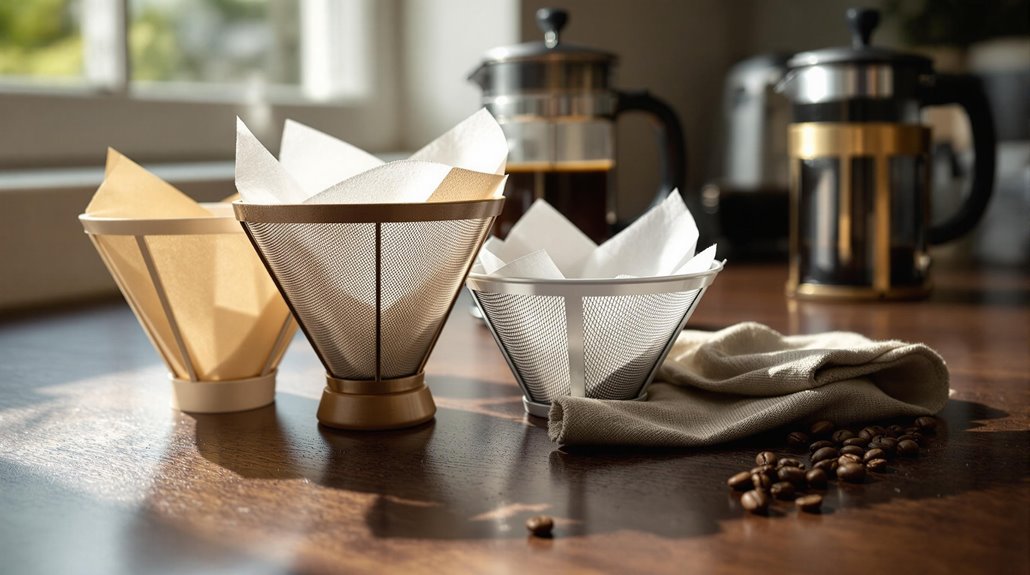
When it comes to brewing coffee, the choice of method and device can substantially impact the final flavor profile of your cup. If you're using drip coffee machines, flat-bottom filters are your best bet. They excel at producing sweeter and more balanced flavors, especially with dark roasts. On the other hand, if you're into pour-over brewing, consider cone-shaped filters like those used in the Hario V60. They enhance citrus and berry notes in lighter roasts, giving you a vibrant tasting experience.
For those who prefer a richer mouthfeel, metal filters are compatible with French presses and reusable pour-over systems, allowing the flavorful oils to pass through. If you opt for cloth filters, often found in manual drip systems, you'll enjoy a full-bodied cup, but remember to clean them thoroughly to avoid mold growth.
Finally, paper filters are commonly used in automatic drip machines and Chemex brewers, offering a clean, sediment-free cup. By understanding these brewing methods and their corresponding filters, you can tailor your coffee experience to suit your taste preferences.
Flavor Profiles and Extraction
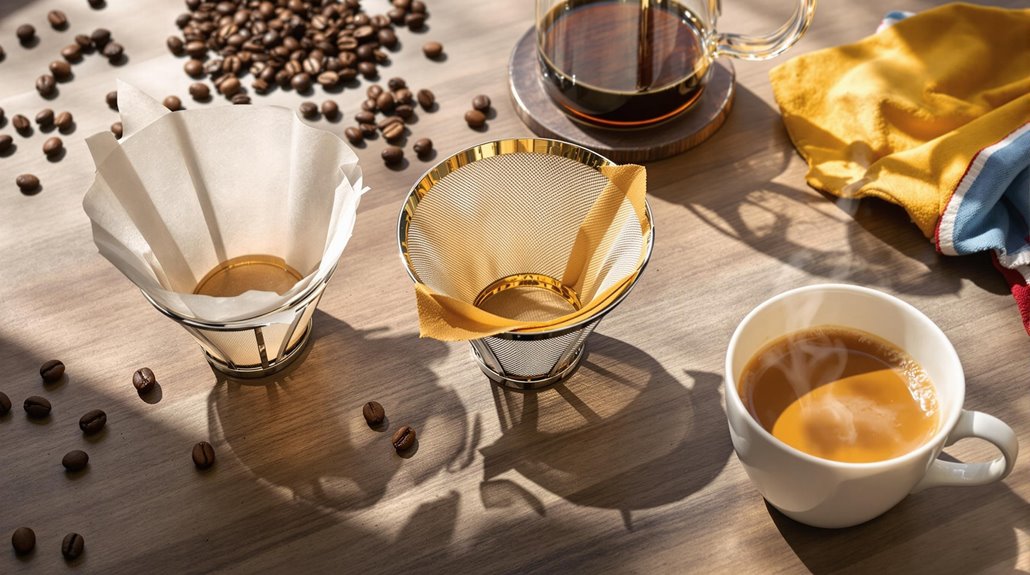
The extraction process plays a pivotal role in determining the flavor profiles of your coffee, and understanding how it works can enhance your brewing skills. Different types of filters interact uniquely with the coffee grounds, impacting the overall flavor of your brewed coffee.
Paper filters absorb coffee oils and trap fine sediments, resulting in a cleaner, lighter cup. This method enhances clarity and brightness, often making it suitable for highlighting delicate flavors in lighter roasts. In contrast, metal filters allow more coffee oils and fine particles to pass through, producing a fuller-bodied, richer flavor with a heavier mouthfeel.
Cloth filters strike a middle ground by retaining some oils while filtering out sediments, offering a smooth, full-bodied cup with minimal bitterness. The shape of the filter also matters; cone-shaped filters promote slower extraction, accentuating fruity and floral notes, while flat-bottom filters provide even extraction, ideal for drawing out sweeter, chocolatey notes in dark roasts.
Cost and Sustainability
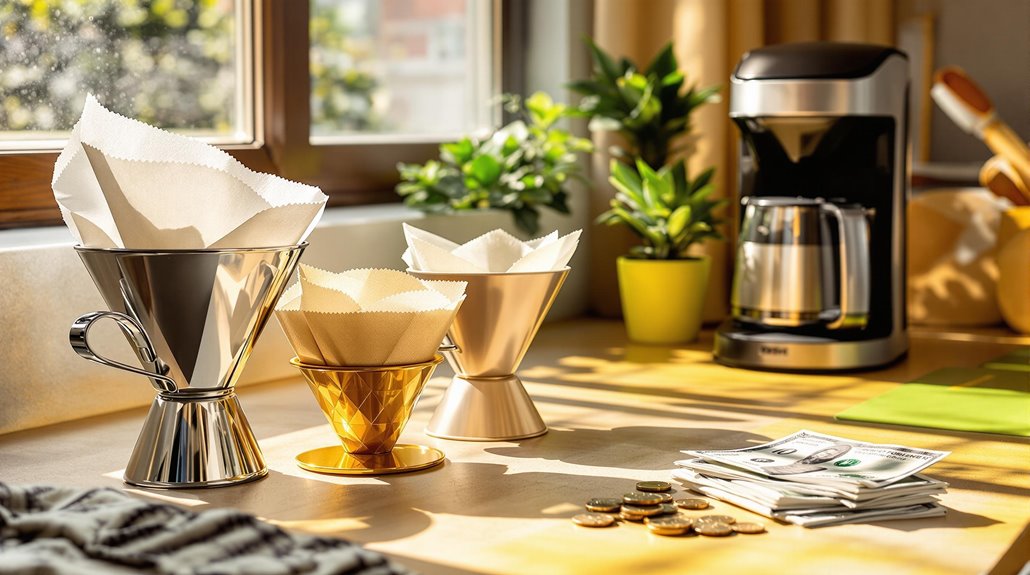
While coffee enthusiasts often prioritize flavor, considering the cost and sustainability of coffee filters is equally important. Paper filters are quite inexpensive, typically costing $0.05 to $0.10 each. However, they generate substantial waste over time. If you're looking for a more sustainable option, reusable filters like metal and cloth are worth considering. Metal filters, priced between $15 and $30, can last for years, ultimately saving you money while eliminating the need for disposable options. Cloth filters, which range from $10 to $20, can be reused for up to 100 brews, striking a balance between cost and sustainability.
Although composting paper filters can reduce their environmental impact, opting for unbleached filters is a more eco-friendly choice. Reusable filters considerably cut down landfill waste, enhancing sustainability, but they do require regular cleaning and maintenance. When evaluating your options, think about how often you brew coffee and the long-term costs versus the initial investment. By choosing the right filter, you can enjoy your coffee guilt-free, knowing you've made a more sustainable choice that aligns with your budget.
Popular Coffee Filter Brands

Many coffee lovers find themselves overwhelmed by the variety of coffee filter brands available, each promising a unique brewing experience. One standout is the Hario V60. Its conical paper filters are designed to enhance flavor clarity and acidity, making it an ideal choice for pour-over enthusiasts who seek a vibrant cup.
On the other hand, the Chemex features thick, bonded paper filters that produce a clean, sediment-free brew with a lighter body. This brand is perfect if you appreciate a smooth taste and a visually appealing presentation, as the Chemex itself is an elegant piece of equipment.
Then there's the Kalita Wave, known for its flat-bottom paper filters that promote even extraction. This brand strikes a balance, allowing for a well-rounded flavor profile that's satisfying for many coffee drinkers.
For those looking for alternatives, consider Able Brewing, which specializes in reusable metal filters like the Kone, ensuring a richer mouthfeel by allowing oils to pass through. CoffeeSock offers reusable cloth filters that retain more oils and flavors, providing a sustainable option without sacrificing taste. Each brand has its merits, so choose based on your brewing preferences.
Tips for Choosing Filters
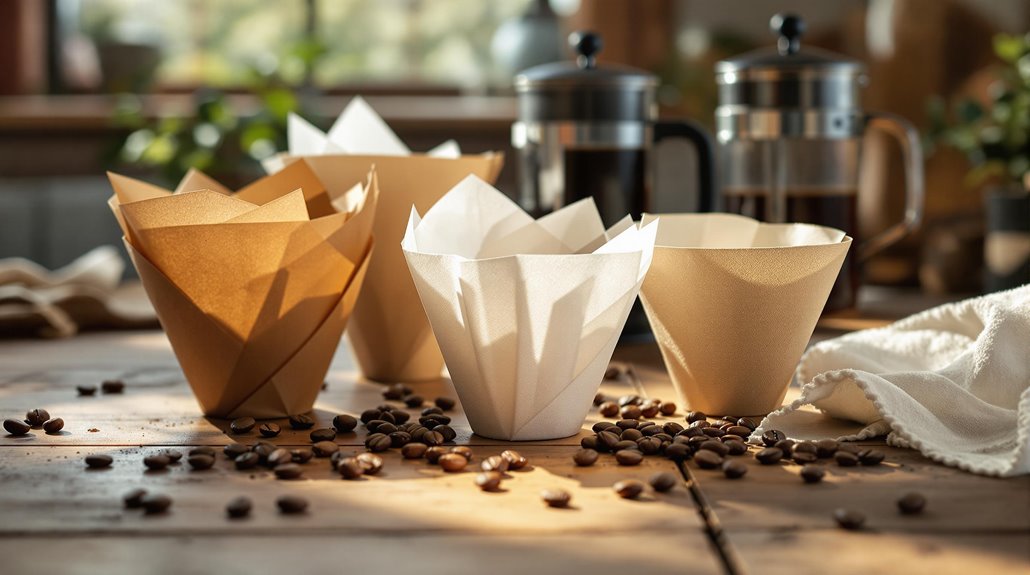
Finding the right coffee filter can greatly improve your brewing experience, so it's essential to explore a few key considerations. First, consider the filter materials. Paper filters provide a cleaner, lighter cup, while metal and cloth filters allow more oils, resulting in a fuller mouthfeel. This choice directly impacts your coffee's flavor profile.
Next, match the filter shape to your brewer. Conical filters work well with pour-over systems like the V60, whereas flat-bottom filters suit devices like the Kalita Wave or automatic machines. Using the correct shape guarantees ideal extraction during the brewing process.
Evaluate maintenance, too. Paper filters are disposable, making cleanup a breeze. In contrast, metal and cloth filters require thorough washing but are reusable and eco-friendly, reducing waste over time.
Lastly, assess the thickness of your filters. Thicker paper filters, like those used in Chemex, block more oils for a cleaner taste. Thinner filters, such as V60 types, let more oils through for a richer flavor. By weighing these factors, you can choose coffee filters that enhance your brewing experience and align with your preferences.
Disclosure: As an Amazon Associate, I earn from qualifying purchases.
